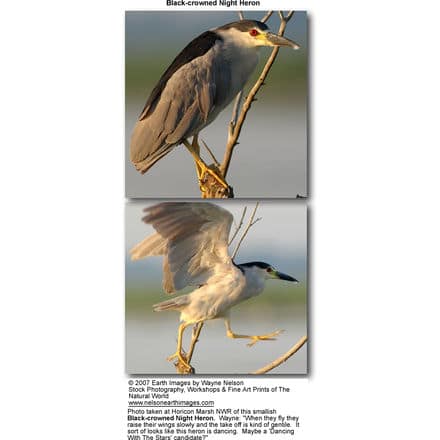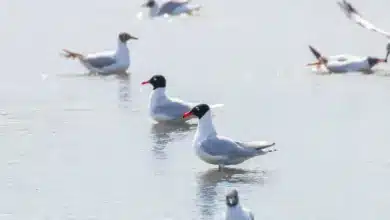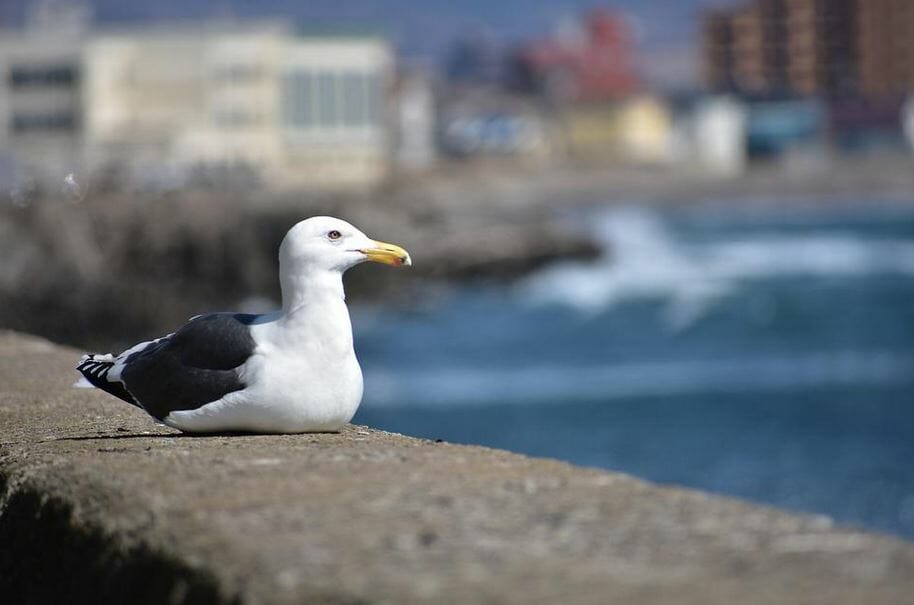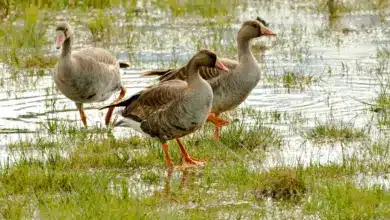Black-crowned Night Herons aka Night Herons
Black Crowned Night Herons Fact Sheet
Heron Information … Heron Species (Listing) … Heron Species Photos
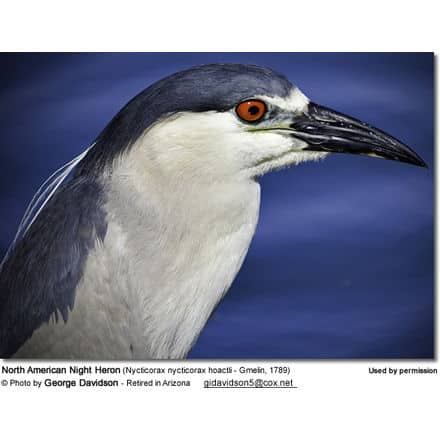
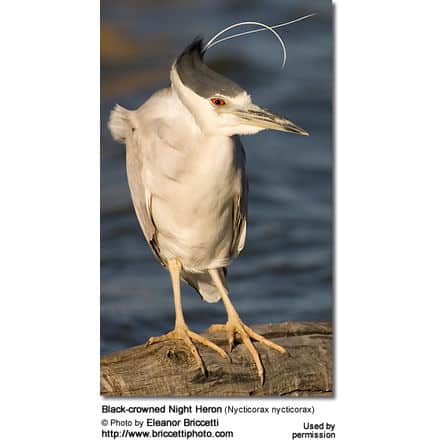
Overview … Alternate (Global) Names
Distribution / Habitat … Subspecies, Ranges and ID … Life Expectancy
Description … Calls / Vocalizations
Breeding / Nesting … Diet / Feeding
The Black-crowned Night Herons (Nycticorax nycticorax) – often simply referred to as Night Herons in Europe – are the most widespread herons in the world. They are found on all continents except Australia and Antarctica.
They are closely related to the Australian Nankeen Night Herons with which they are known to have hybridized in areas where their ranges overlap – namely, the islands of Java and Sulawesi in Indonesia, and the Philippines.
As suggested by their common name, these herons are most active during the night and are usually resting in trees or bushes during the day.
Their nocturnal habits may have their origin in these birds wishing to minimize competition for food with other water birds; or to avoid harassments from other birds that are aware of the night herons’ habits of feeding on their eggs and young, and have, therefore, learned to attack night herons on sight.
 Distribution / Migration / Habitat
Distribution / Migration / Habitat
Their range spans across five continents, including the Americas, Europe, Africa and Asia.
Populations found in tropics are generally resident; however, those breeding in the northern parts may migrate south for the winter.
Migration
Migratory birds breeding in North America usually winter in southern United States, Mexico, Central America and the West Indies (Caribbean islands); and those occurring in Europe generally winter in tropical Africa and southern Asia.
Migration patterns vary depending on their range, however, those occurring in the Americas migrate to their breeding grounds from February to May. From July through October, they generally travel back to their wintering territories. The migration is typically done in large flocks and almost exclusively during the night.
Habitat
They breed in fresh and salt-water wetlands, including marine islands, swamps, wooded streams, rivers, canals, marshes, mud flats, tropical mangroves, and the edges of lakes and ponds that have become overgrown with rushes and cattails. They have also been observed in agricultural fields and suburbs of large cities.
They generally remain close to water and favored vegetation, such as trees, mangroves and reeds – where they roost, feed and breed.

 Status / Conservation
Status / Conservation
Population declines in the late 1960s were attributed to the use of DDT (an agricultural insecticide). Additionally, Black-crowned Night Herons are hunted for food, in particular the young birds; or they are trapped and killed at fish farms, where these birds compete for the fishy prey. Those nesting close to human settlements are also considered pests by some. However, alternate methods have been put in place to manage many problems associated with these birds, without the need to slaughter them.
In recent history, they share the same threads as most other water birds: loss / destruction of their wetland habitats, water pollution and the overuse of pesticides.
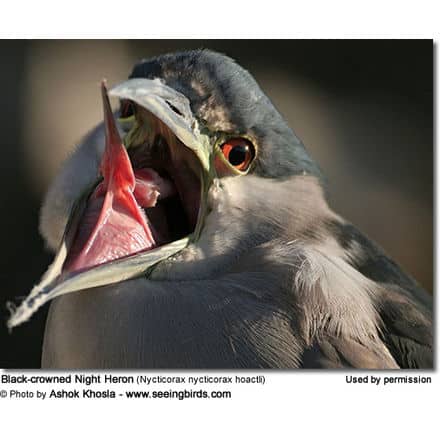
 Recognized Subspecies and Ranges:
Recognized Subspecies and Ranges:
- Black-crowned Night Heron (Nycticorax nycticorax nycticorax – Linnaeus, 1758) – Nominate Race
- Range: Central and southern Europe eastwards to central and southern Asia (including India), extending north to Japan and south to Timor in Indonesia; Africa and the island of Madagascar.
- North American Night Heron (Nycticorax nycticorax hoactli – Gmelin, 1789)
- Range: North, Central and South America: Found across North America from Oregon (only wintering populations) and Washington State (some resident birds) east through Saskatchewan and southern Quebec and New Brunswick (southern Canada), south through the USA (avoiding the Rocky Mountain region) and coastal Mexico, as well as locally in Central America and the Caribbean, and through South America to Chile and northern Argentina. This race tends to be more sociable than the nominate form, and typically occurs in flocks outside the breeding season
- Dusky Black-crowned Night Heron (Nycticorax nycticorax obscurus – Bonaparte, 1855)
- Range: Southernmost South America, from northern Chile and north central Argentina south to Tierra del Fuego (the southernmost tip of the South American mainland)
- Falkland Night Heron (Nycticorax nycticorax falklandicus – Hartert, 1914)
- Range: South America: Falkland Islands in the South Atlantic Ocean (east of the coast of mainland South America).
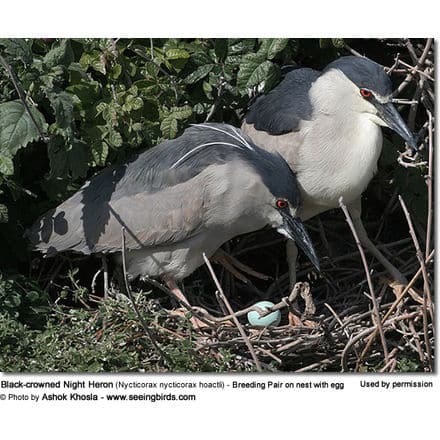
Description
Adults
Black-crowned Night Herons are small, stocky, short-necked and short-legged compared to other heron species. They measure 23 – 28 inches (58 – 71 cm) in length (including the tail), with an average height of 25 inches (64 cm) and a wingspan of 44 – 47 inches (112 –118 cm). Their weight ranges from 26 – 36 oz (727 – 1,014 g), with an average weight of 28 oz (800 g).
Their tri-colored plumage sports a black crown and back, pale blue-grey wings and tail, whitish eye brows and lores (area between the beak and the bill), and whitish underparts.
The eyes are bright red; and the short legs and feet are yellowish-green in non-breeding birds and pinkish-red when breeding. The black bill is slightly curved downward.
Males and females look alike, except females tend to be a little smaller in size.
Breeding birds grow two or three long white plumes on their heads (on the nape – lower back of the neck) that are erected during greeting and courtship displays. The black feathers on the head and back take on a bluish-green gloss. The legs turn pinkish red in color.
When hunting, they extend their necks.
When resting, they are usually somewhat hunched, as the head is tucked down into the shoulders.
Movements in Water: They are fairly good swimmers and are able to land on the surface of water.
In flight, the white underparts are most obvious; the neck is tucked in close to the body so that the head and back from a straight line, and the short legs barely extend barely beyond its tail. The arched wings move in deep strokes. They can fly 20 to 35 miles (~32 – 56 km) per hour.

Immature Description
Birds younger than one year have a duller dark grey-brown plumage except for pale spots on the darker wings; broad, white streaks on the brown head; and indistinct brown spots and streaks on the paler underparts. The legs are dull grey (sometimes described as yellowish-green). The bill is orangey-yellow.
Juveniles first have grey eyes, turning yellow over the first year and finally red as adult.
When they are about two years old, their crown and back turn brownish-black; the rest of the body is brown and faint streaking can be seen below.
They reach their adult plumage when they are about 3 years old, at which point they also reach breeding age.
Similar Species
Adults resemble the Yellow-crowned Night Herons and the American Bitterns, but can be identified by their white underside.
Yellow-crowned Night Herons are grey below and the American Bitterns are cream-colored below with chestnut stripes.
Young birds can be confused with juvenile Striated or Little Herons (Butorides striatus) or the Cinnamon Bitterns (Ixobrychus cinnamomeus); however, the Black-crowned juvenile can be identified by the spots on the back, their stockier shape and robust beaks.
Breeding / Nesting
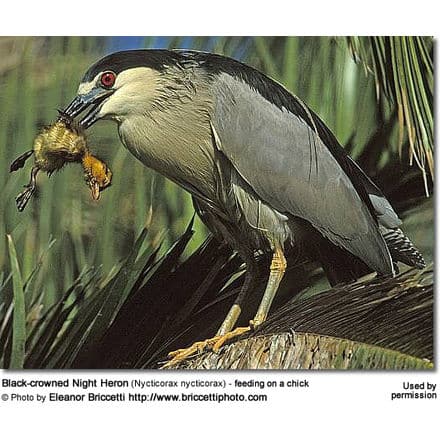
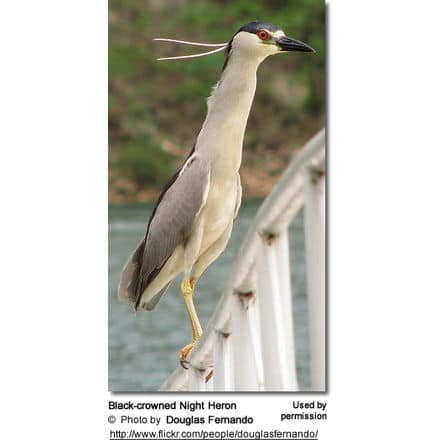
Diet / Food:
Black-crowned Night Herons primarily feed on small fish. However, these opportunistic feeders will also take frogs, aquatic and terrestrial insects, leeches, earthworms, crayfish, mussels, squid, reptiles (lizards, snakes), small mammals (rodents), plants, and even carrion and garbage at landfills. They will also take the eggs and nestlings of colonial-nesting waterbirds, such as terns, herons and ibises, and hunt small birds.
Most feeding occurs in shallow waters, where they grasps their prey with their bills, rather than stabbing them as other water birds tend to do. One of the techniques they utilize to attract prey is referred to as “bill vibrating” – they will open and close the bill rapidly in water, which creates a disturbance that lures prey. They may also stand motionless in water for long periods, with their necks tucked in a hunched posture until prey comes within range before striking out to catch them. When hunting, they also jump on water feet first or plunge from the air to catch prey.
They may walk about or swim in search of food. They shake their prey vigorously until stunned or killed and then they swallow them head first. The strong digestive acids in their stomachs can easily dissolve bones.
Most feeding is done early morning and at dusk, when all other herons are asleep thus avoiding competition with waterbirds sharing the same habitat. However, when food is scarce, competition high, during the breeding season, or whenever special opportunities afford themselves, they may also hunt during the day.
They are usually solitary forager and aggressively defend their feeding territories; and typically use the same feeding sites repeatedly.
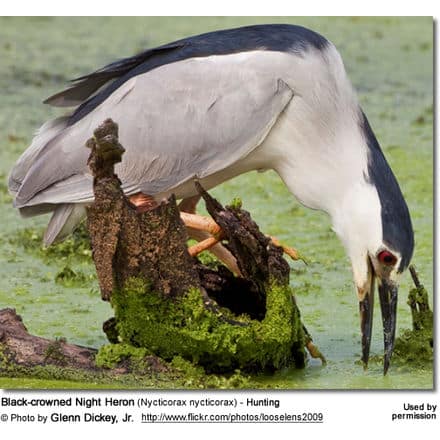
 Calls / Vocalizations
Calls / Vocalizations
Their contact calls are a loud and harsh ‘Qua,’ ‘Quak,‘ ‘Quark‘, ‘kwark’ or ‘kwok‘, and are most commonly given in flight or from a perch. While migrating, they call to keep in contact with each other and remain close to one another.
Life expectancy
Black-crowned Night Herons have a maximum lifespan of 30 years in captivity and only about 20 – 21 years in the wild, where they are unprotected from predation and environmental hazards.
Alternate (Global) Names
Scientific Name:
The scientific / Latin name, Nycticorax, means “night raven”, and refers to this species’ nocturnal habits and harsh crow-like calls.
Common Names
Their common name “night heron” is a result of their nocturnal habits.
In many parts of the world, these birds have been named for the sound of their natural calls, such as in the Falkland Islands, where this heron is referred to as “quark”; “kwak” in Dutch and Frisian (the language of the Frisians found Frisia, a coastal region along the southeastern corner of the North Sea); “kvakoš no?ní” in Czech, “????” in Ukrainian, “??????” in Russian, “V?c” in Vietnamese, “Kowak-malam” in Indonesian, and “Waqwa” in Quechua (the language of the Quechua people found in the central Andes of South America).
Global Names:
Afrikaans: Gewone Nagreier … Albanian: Çapka e natës … Arabic: ????? ?????? ??????, ???? ????? … Armenian: ?????? … Asturian: Garcina de Nueche, Garcina de Nuechi … Azerbaijani: Qar?ldaq … Basque: Amiltxori arrunta, Martinet de nit … Belarusian: ?????-?????? … Bulgarian: ????? ????? … Breton: Ar gerc’heiz kein du … Catalan: Martinet de nit, Orval … Chinese: ? ?, ??, ?? … Cornish: Kerghyth nos … Croatian: Gak … Czech: Kvakoš nocní, Kvakoš no?ní, kvakoš noèní … Danish: Nathejre … Dutch: Kwak … Esperanto: Noktardeo … Estonian: Ööhaigur … Georgian: ????? ????? … German: Nachtreiher … Greek: ????????????, ????????????, ???????????? … Guarani: Tajasu guyra … Haitian Creole French: Kòk lannwit kouwòn nwa … Hawaiian: ‘Auku’u … Hebrew: ???? ????, ???? ???? … Hindi: Vakka … Hungarian: Bakcsó … Icelandic: Nátthegri … Indonesian: Kowak, Kowakmalam Abu … Irish: Corr Oíche … Italian: Nitticora, Nitticora comune … Japanese: goisagi, Goi-sagi … Kazakh: ???????? ????? … Korean: ???? … Kwangali: Hakaruu Gomasiku … Latvian: Nakts g?rnis … Lithuanian: Naktikovas, Naktikovis … Macedonian: ???, ??????, ????? ????? … Malagasy: Doaka, Goadrano, Goaka, Koaka, Rahoaka … Malay: Pucong Kuak, Pucung Kuak … Maltese: Kwakka … Mamasa: dakko-dakko … Norwegian: Natthegre … Polish: slepowron, ?lepowron, ?lepowron zwyczajny … Portuguese: arapapá-de-bico-comprido, dorminhoco, garça-cinzenta, Garca-dorii-iinhoca, garça-dorminhoca, Garça-nocturna, Goraz, guacuré, guacuru, guarucu, savacu, socó, socó-dorminhoco, socó-galinha, Socó-taquari, taiassu, tajaçu, taquari, taquiri … Russian: Kvakva, ??????, ?????? ????????????, ???????????? ?????? … Serbian: gak, Nocna caplja, Nocna caplja, gak, ???, ????? ?????? … Slovak: bu?iak no?ný, chavkoš no?ný, Chvakoš no?ný … Slovenian: kvakac, kvaka? … Spanish: Garza bruja, Garza nocturna corona negra, Garza Nocturna Coroninegra, Garza-nocturna Coroninegra, Guaco Común, Guanabá de la Florida, Huairavo, Huairavo del Norte, Martinete, Martinete Capinegro, Martinete Comun, Martinete Común, Martinete coroninegro, Pedrete Corona Negra, pedrete corona-negra, Rey Congo Cabeza Negra, Yaboa Real … Faroese: Nátthegri … Finnish: Yöhaikara … French: Bihoreau à couronne noir, Bihoreau à couronne noire, Bihoreau gris, Héron bihoreau, Héron bihoreau à calotte noire … Swedish: Natthäger … Swahili: Kingoyo Utosi-weusi … Thai: ?????? … Turkish: Gece Bal?kç?l?, gece balykçyly … Ukrainian: ???? … Vietnamese: V?c … Welsh: Crëyr y nos, Cr?yr y Nos … Zulu: uSiba
Species Research by Sibylle Johnson
Please Note: The articles or images on this page are the sole property of the authors or photographers. Please contact them directly with respect to any copyright or licensing questions. Thank you.

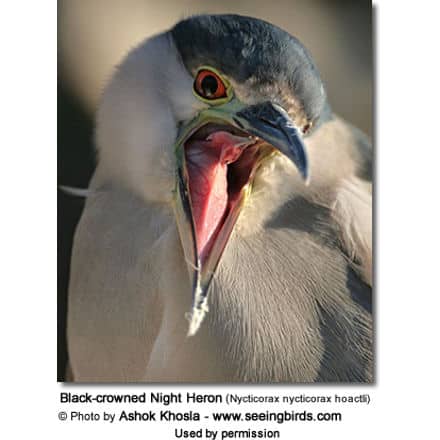 Distribution / Migration / Habitat
Distribution / Migration / Habitat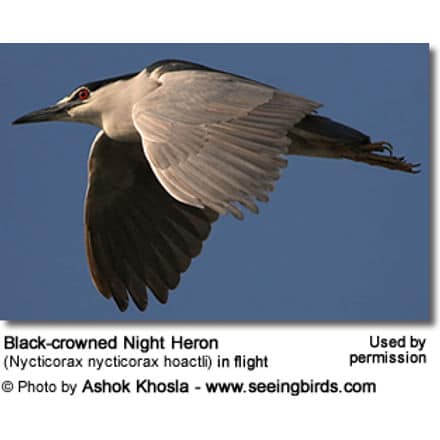 Status / Conservation
Status / Conservation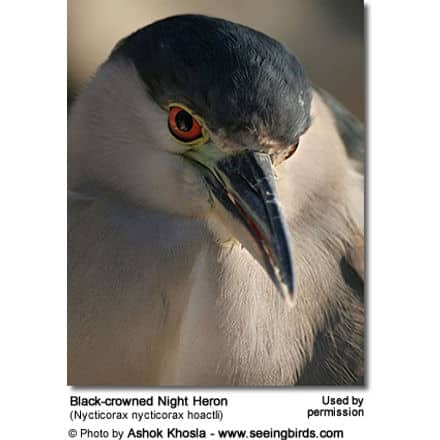 Recognized Subspecies and Ranges:
Recognized Subspecies and Ranges:
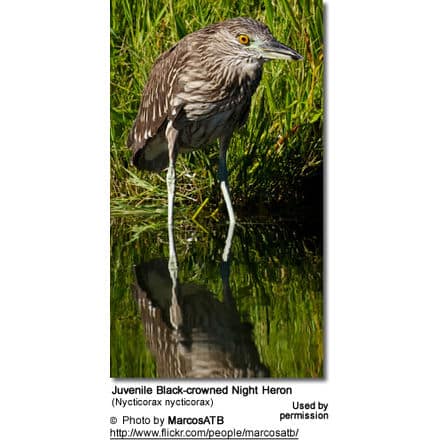
 Calls / Vocalizations
Calls / Vocalizations